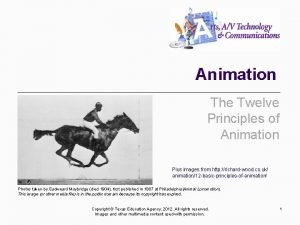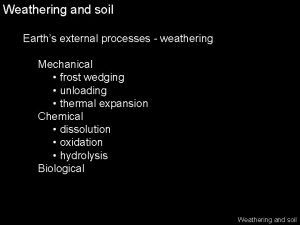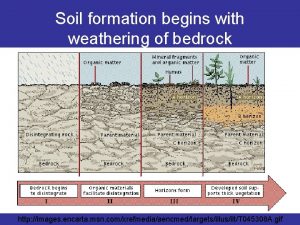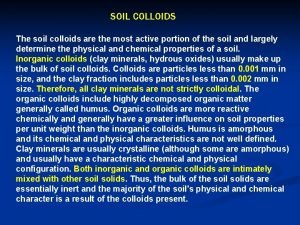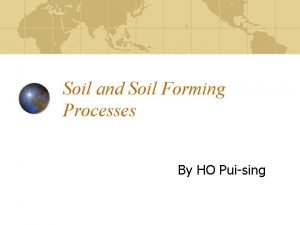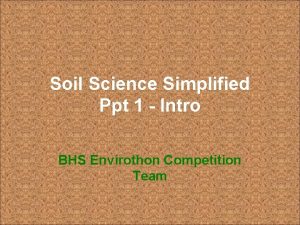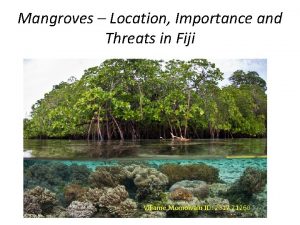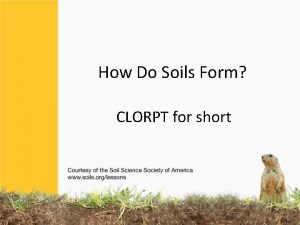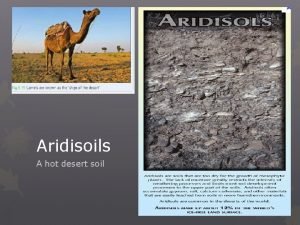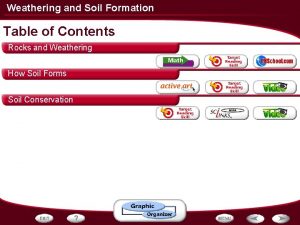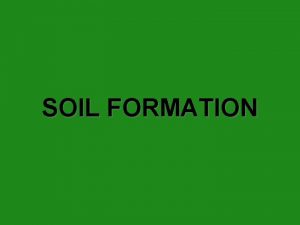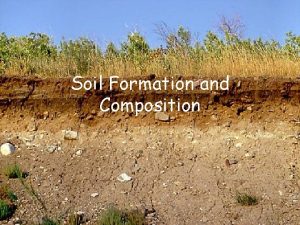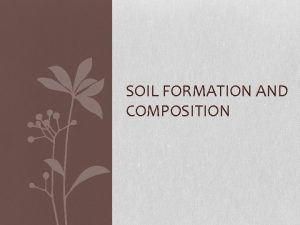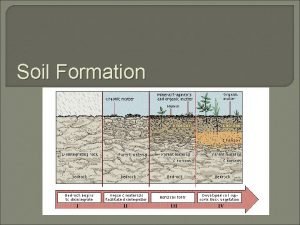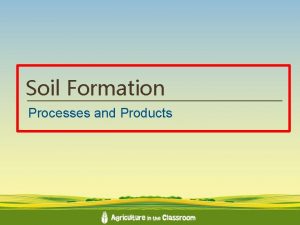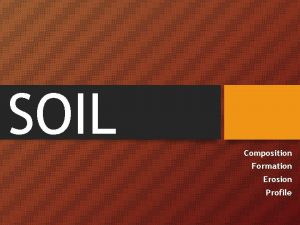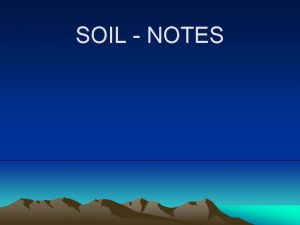Soil as a System Soil formation is slow












- Slides: 12

Soil as a System

Soil formation is slow and complex • Parent material—base geological material in a particular location, can include lava or volcanic ash, rock or sediment deposited by glaciers, etc • Bedrock—the continuous mass of solid rock that makes up earth’s crust • Weathering—describes the physical chemical and biological processes that break down rocks and minerals, turning large particles into smaller particles

(cont) • Types of weathering: – Physical—breaks down rock without triggering a chemical change in the parent material. Wind and rain are main forces of physical weathering – Chemical weathering—results when water or other substances chemically interact with parent material, accelerated by warm wet conditions

(cont) – Biological weathering—occurs when living things break down parent material by physical or chemical means. Lichens, for example, initiate primary terrestrial succession by producing acid which chemically weathers rock

(cont) • Erosion—movement of soil from one area to another, may sometimes help form soil in one locality by depositing material it has depleted from another • Although erosion can sometimes help build new soil in the long term, on the timescale of human lifetimes and for the natural systems on which we process that reduces the amt of life that a given area of land can support

A soil profile consists of distinct layers known as horizons • Each layer of soil is known as a horizon, and the cross section as a whole from surface to bedrock is known as a soil profile • eluviation=“loss” • illuviation=“accumilation”

Soil can be characterized by color, texture, structure, and p. H • Soil color – Black or dark = usually rich in organic matter, while pale gray to white often indicates leaching or low organic content • Soil texture – Determined by the size of particles and is the basis on which the USDA assigns soils to one of three general categories • Clay—smallest particles, silt—medium sized, sand—largest of the three • Size determines soil porosity (measure of the size of spaces bw particles, usually increases the larger the particles themselves) • Soil structure – Clumpiness of soil. How clumpy is it”? • Soil p. H – The degree of acidity influences a soil’s ability to support plant growth

(cont) -regional differences in soil traits can affect agriculture

Soil Degradation: problems and solutions • Erosion can degrade ecosystems and agriculture – Erosion becomes a local problem for ecosystems and agric because it nearly always takes place much more quickly than soil is formed • Soil erodes by several mechanisms – Splash erosion (from rain), rill erosion, sheet erosion, gully erosion (just be familiar with these names) • Aird land may lose productivity by desertification – Desertification—a loss of more than 10% productivity due to erosion, soil compaction, forest removal, overgrazing, dought, salinization, climate change, depletion of water sources, and other factors • The dust bowl was a monumental event for the US – During the early 1930 s a drought in the southern great plains of the US directly showed the effect of human activities on soil—region’s strong winds began to carry away millions of topsoil, dusdt bowl, “black blizzards” • The soil conservation service pioneered measures to slow soil degradation – -soil conservation act of 1935, soil conservation service worked closely with farmers to develop conservation plans for indiv farms

cont • Farmers can protect soil against degradation in various ways: – Crop rotation – Contour farming – Intercropping – Terracing – Shelterbelts – Reduced tillage

Cont • Erosion control partcies protect and restore plant cover • Irrigation has boosted productivity butt has also caused long term soil problems • Salinization is easier to prevent than to correct • Agric fertilizers boost crop yields but can be over -applied • Grazing practices can contribute to soil degradation

HA HA
 Animation plus
Animation plus Formation initiale vs formation continue
Formation initiale vs formation continue Slow chemical communication system
Slow chemical communication system Venn diagram of chemical and mechanical weathering
Venn diagram of chemical and mechanical weathering Soil formation begins with the weathering of
Soil formation begins with the weathering of What is soil colloids
What is soil colloids Eluviation vs illuviation
Eluviation vs illuviation Shear strength of soil ppt
Shear strength of soil ppt Soil formation
Soil formation Soil formation
Soil formation Ciorpt
Ciorpt Desert soil layers
Desert soil layers 5 factors of soil formation
5 factors of soil formation
